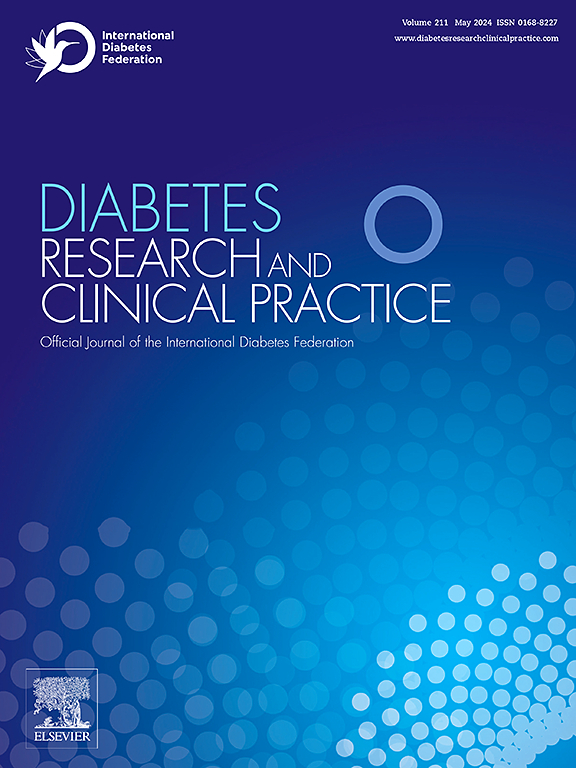2型糖尿病患者心力衰竭住院后钠-葡萄糖共转运蛋白2抑制剂的使用趋势:一项基于人群的研究
IF 6.1
3区 医学
Q1 ENDOCRINOLOGY & METABOLISM
引用次数: 0
摘要
钠-葡萄糖共转运蛋白2抑制剂(SGLT2i)是2型糖尿病(T2D)和心力衰竭(HF)患者治疗的支柱。尽管是心脏-肾脏事件的高危人群,但对住院后SGLT2i的摄取知之甚少,这是处方的关键机会。方法使用相关的管理数据,我们确定了2014年1月至2021年6月在澳大利亚新南威尔士州因心衰住院的成人T2D患者。我们测量了2020-2021年SGLT2i使用流行率的季度趋势以及与使用相关的因素。结果:18932例t2dm合并HF住院患者。我们发现SGLT2i的使用量增加了13倍,到2021年年中达到13.2%。SGLT2i在男性(调整优势比[aOR] = 1.49, 95%可信区间[CI]: 1.24-1.79)和原发性诊断为HF的人群(aOR = 1.21, 95% CI: 1.01-1.45)中使用较高,在老年人群(≥85岁vs 18-64岁:aOR = 0.18, 95% CI: 0.12-0.26)中使用较低,在临床复杂性增加的人群中(例如较高的Charlson评分;虚弱)和慢性肾脏疾病(aOR = 0.60, 95% CI: 0.48-0.75)。结论:虽然合并心衰的t2dm患者使用SGLT2i有所增加,但吸收率仍然很低。优化从医院到社区护理过渡阶段的药物使用,可以确保这些药物的临床效益得以实现。本文章由计算机程序翻译,如有差异,请以英文原文为准。
Trends in use of sodium-glucose cotransporter 2 inhibitors among people with type 2 diabetes following hospitalisation with heart failure: A population-based study
Aims
Sodium-glucose cotransporter 2 inhibitors (SGLT2i) are a pillar of therapy among people with both type 2 diabetes (T2D) and heart failure (HF). Despite being a population at high-risk of cardio-renal events, little is known on SGLT2i uptake following hospitalisation, a key opportunity for prescribing.
Methods
Using linked administrative data, we identified adults with T2D hospitalised with HF from January 2014 to June 2021, New South Wales, Australia. We measured quarterly trends in prevalence of SGLT2i use, and factors associated with use in 2020–2021.
Results
We identified 18,932 people with T2D hospitalised with HF. We found a 13-fold increase in SGLT2i use, reaching 13.2 % by mid-2021. SGLT2i use was higher in males (adjusted odds ratio [aOR] = 1.49, 95 % confidence interval [CI]: 1.24–1.79) and people with a primary diagnosis of HF (aOR = 1.21, 95 % CI: 1.01–1.45), lower in older age groups (≥85 vs 18–64 years: aOR = 0.18, 95 % CI: 0.12–0.26), among people with increasing clinical complexity (e.g. higher Charlson Score; frailty) and chronic kidney disease (aOR = 0.60, 95 % CI: 0.48–0.75).
Conclusions
While SGLT2i use has increased among people with T2D hospitalised with HF, uptake remains low. Optimising medication use at transitions from hospital to community care may ensure clinical benefits of these medicines are realised.
求助全文
通过发布文献求助,成功后即可免费获取论文全文。
去求助
来源期刊

Diabetes research and clinical practice
医学-内分泌学与代谢
CiteScore
10.30
自引率
3.90%
发文量
862
审稿时长
32 days
期刊介绍:
Diabetes Research and Clinical Practice is an international journal for health-care providers and clinically oriented researchers that publishes high-quality original research articles and expert reviews in diabetes and related areas. The role of the journal is to provide a venue for dissemination of knowledge and discussion of topics related to diabetes clinical research and patient care. Topics of focus include translational science, genetics, immunology, nutrition, psychosocial research, epidemiology, prevention, socio-economic research, complications, new treatments, technologies and therapy.
 求助内容:
求助内容: 应助结果提醒方式:
应助结果提醒方式:


